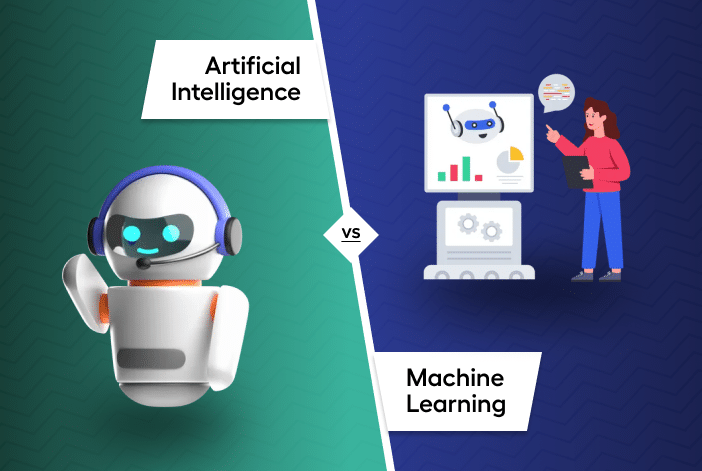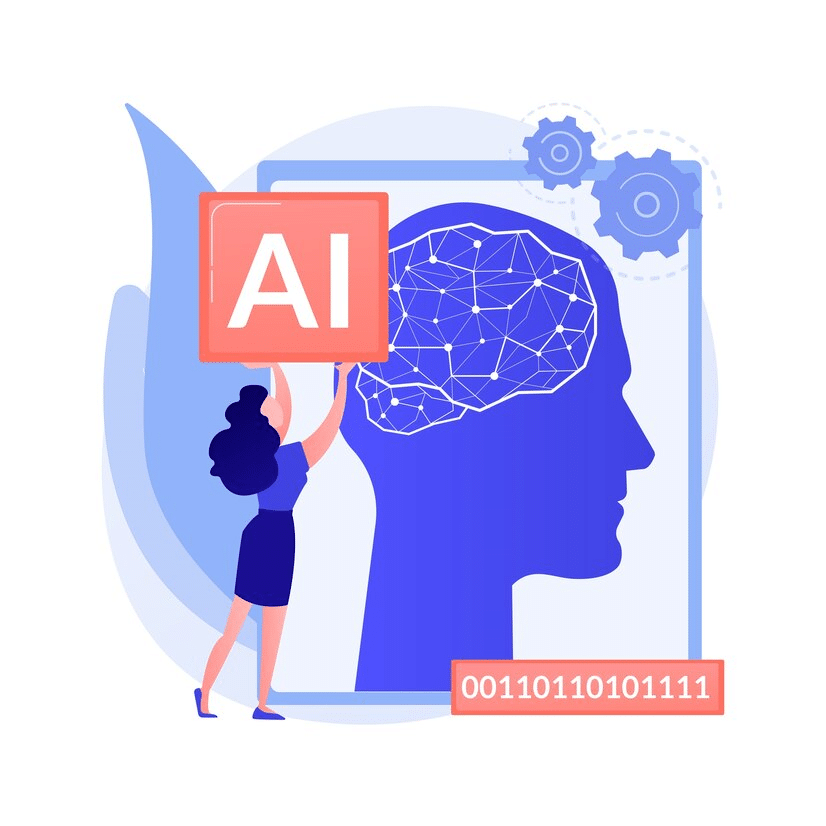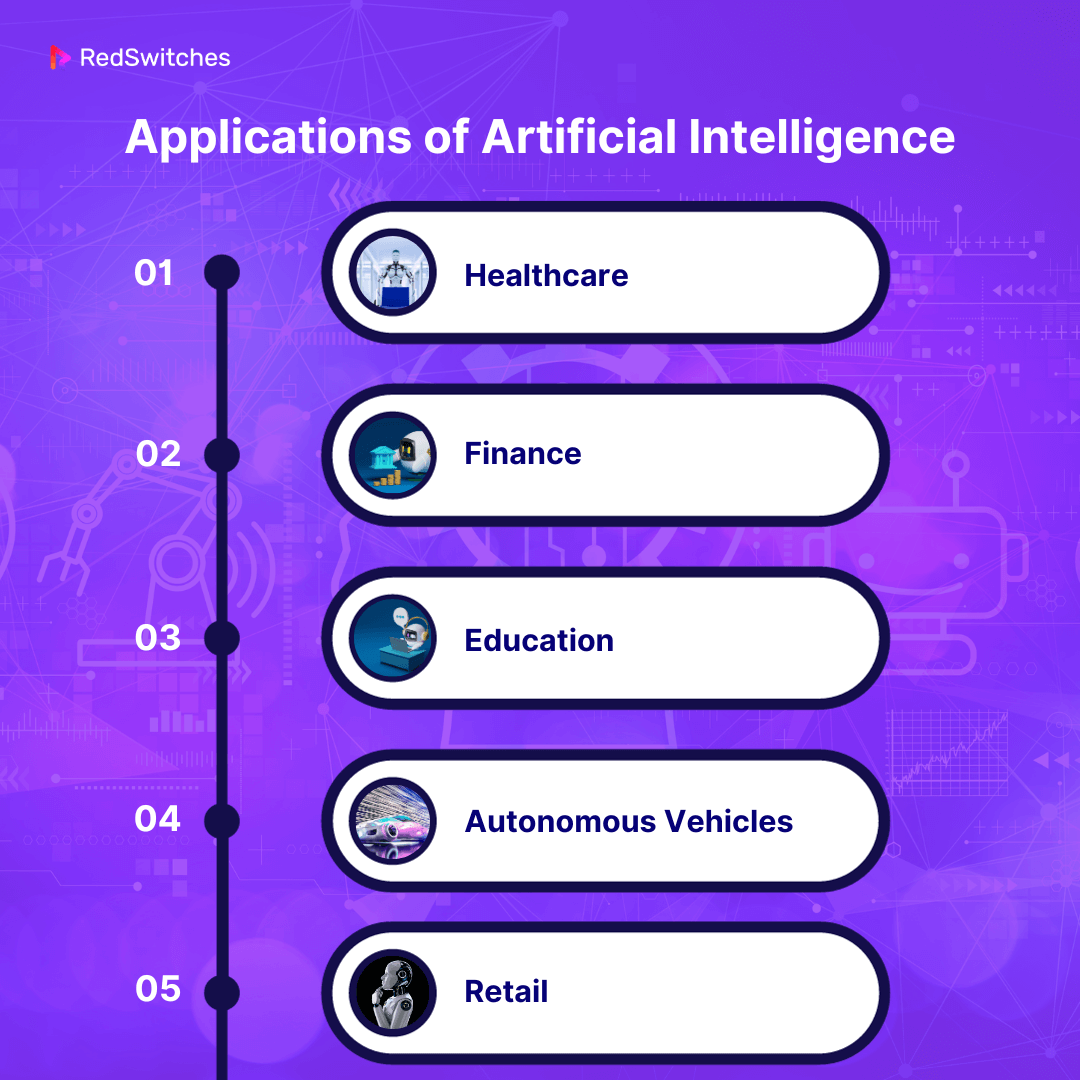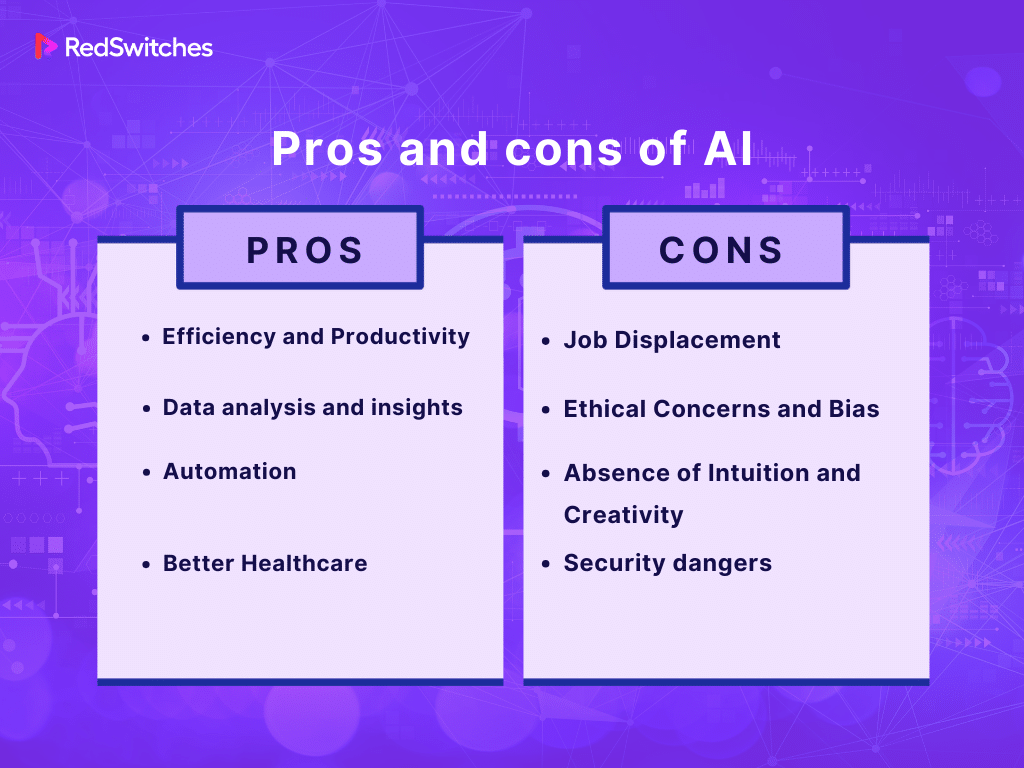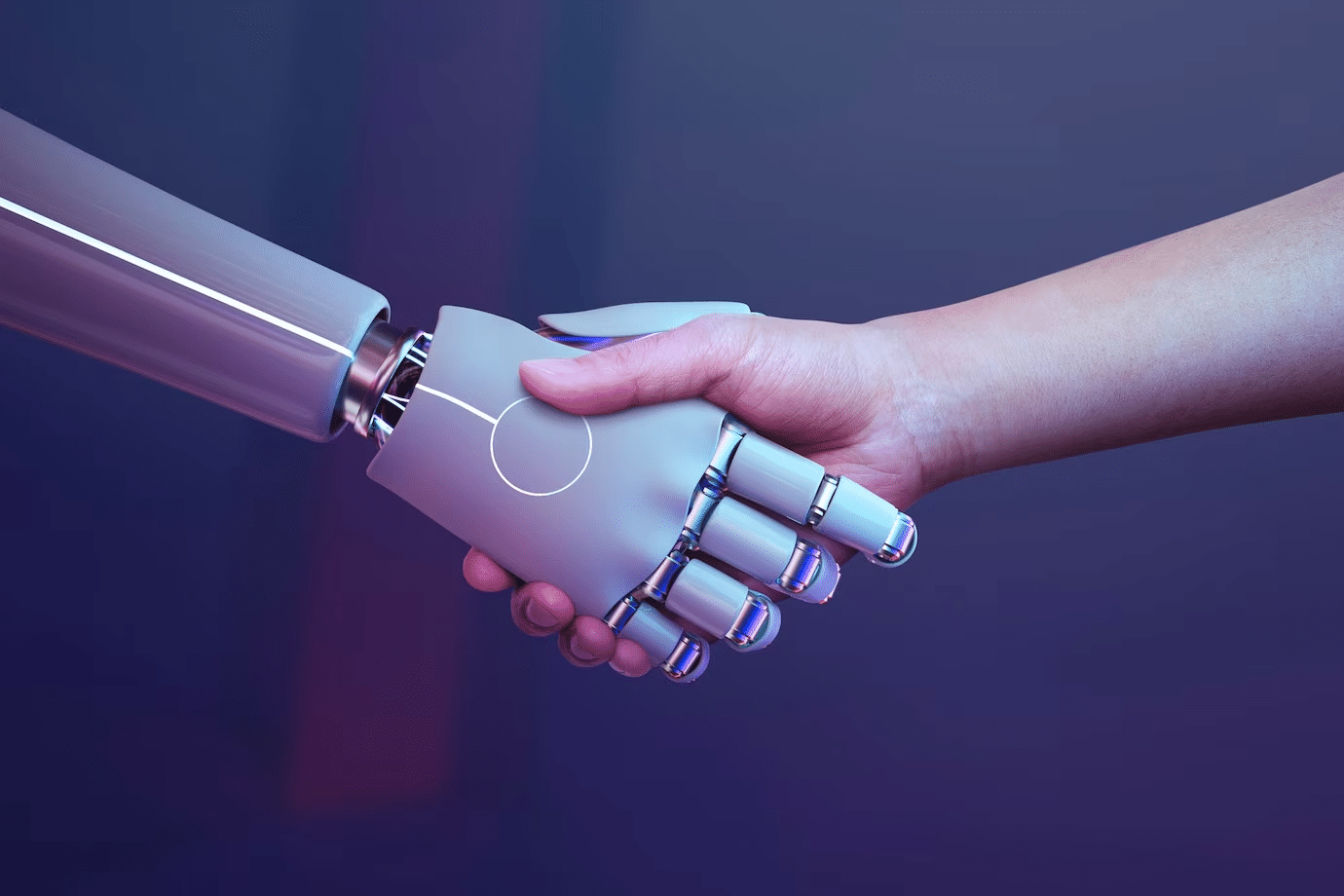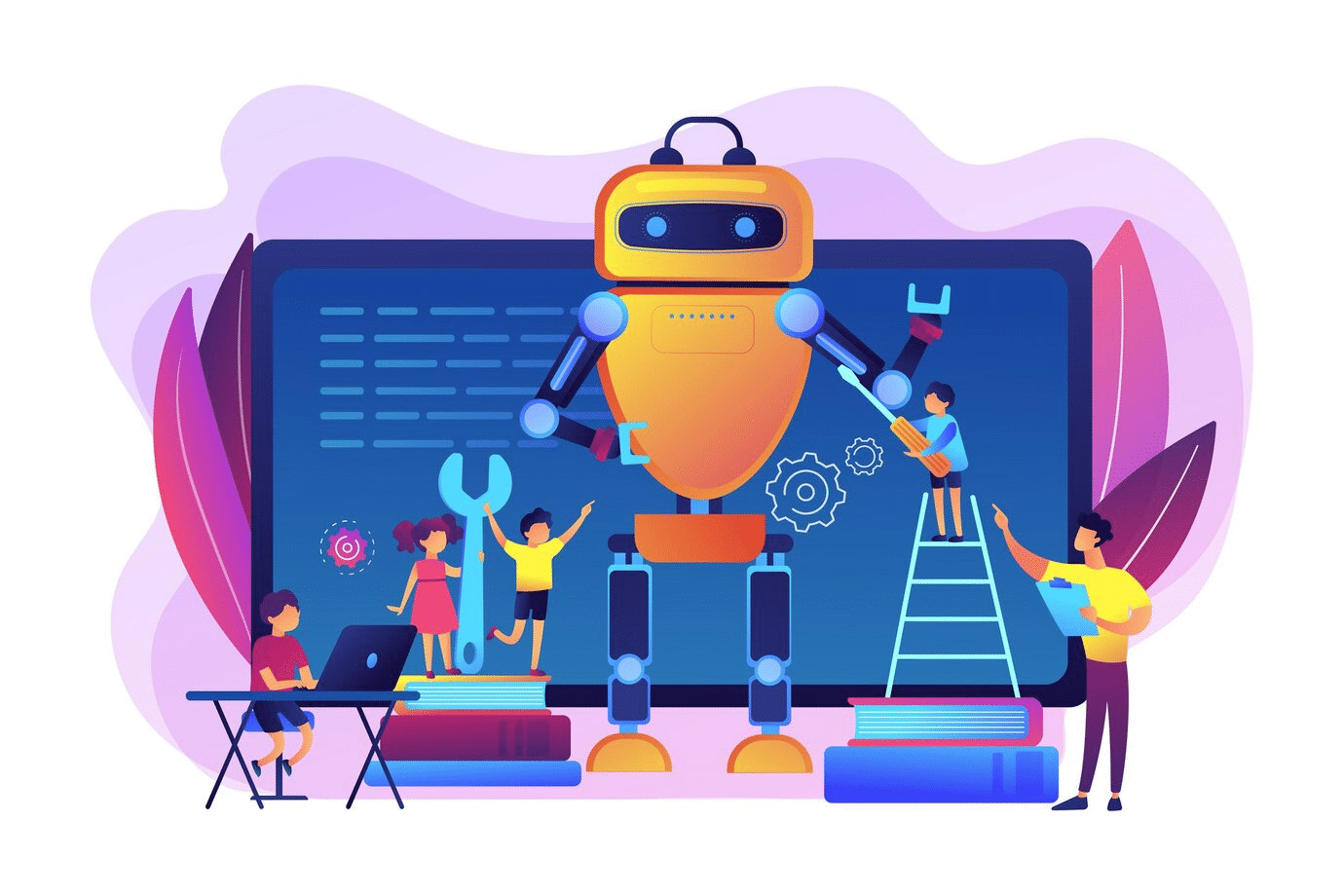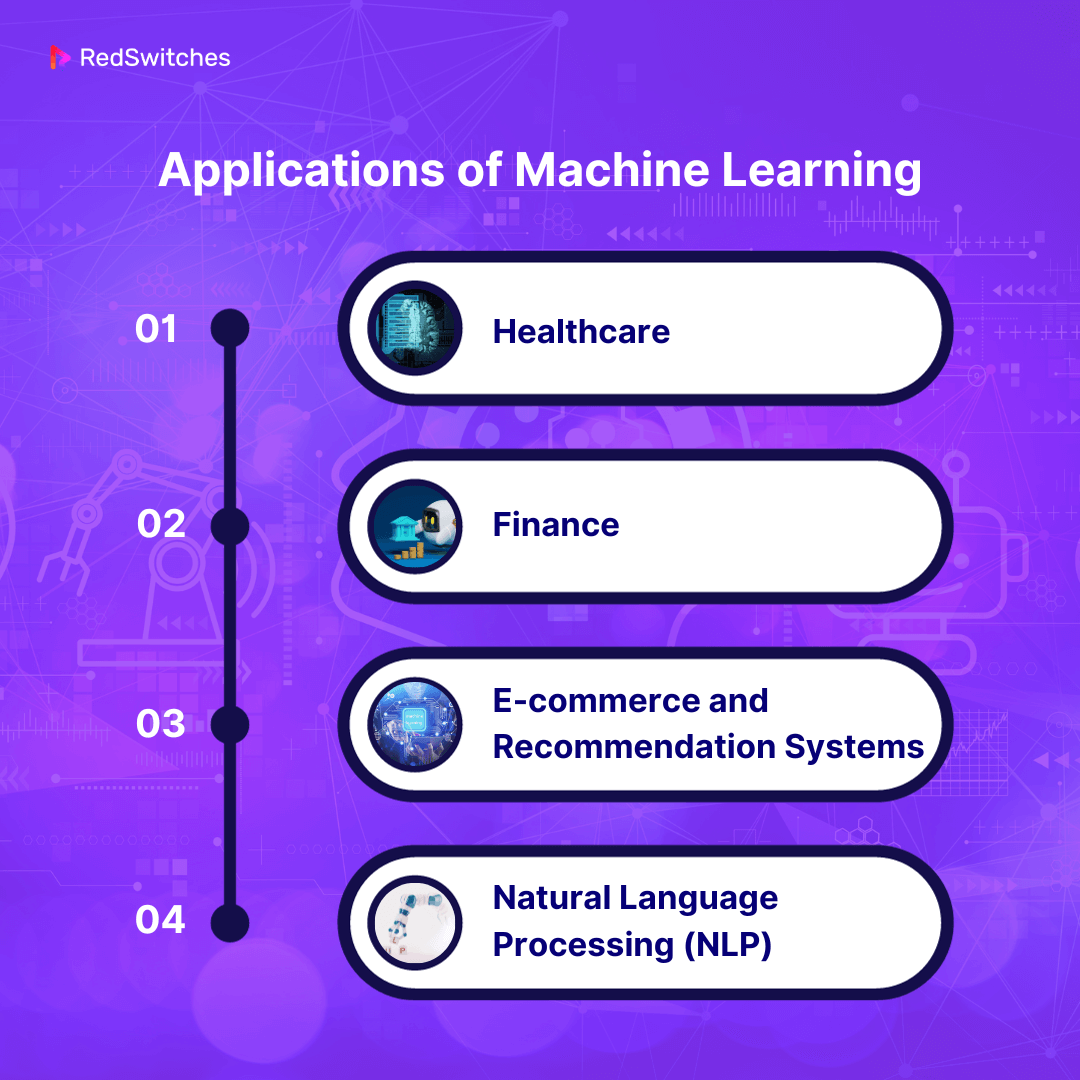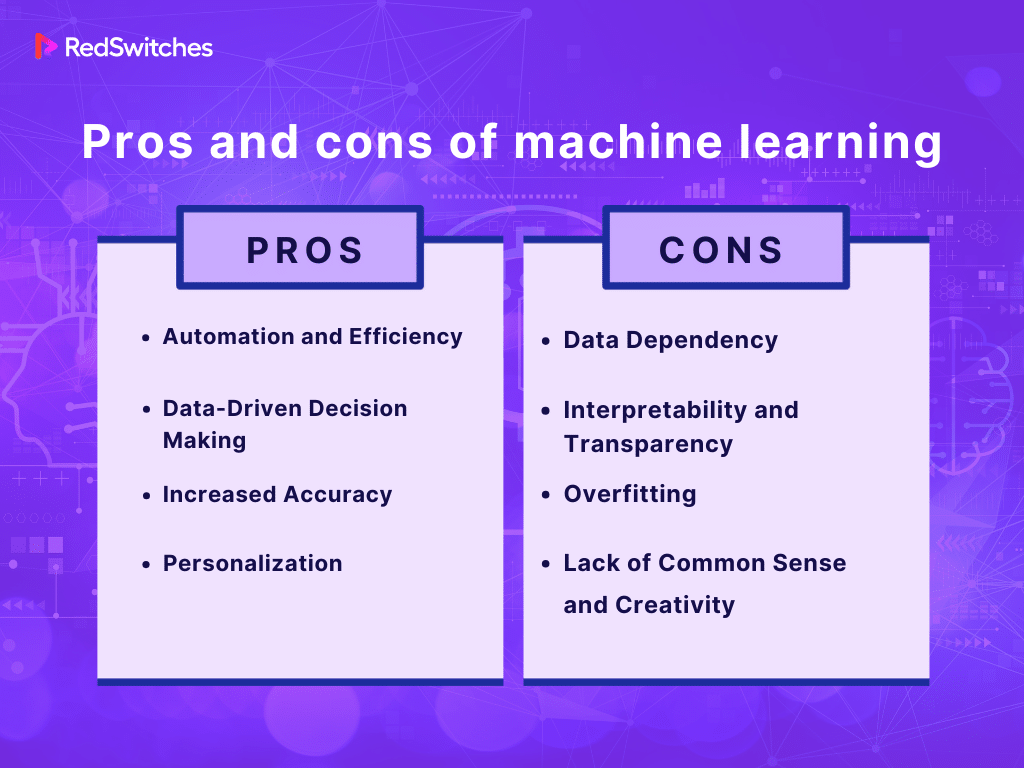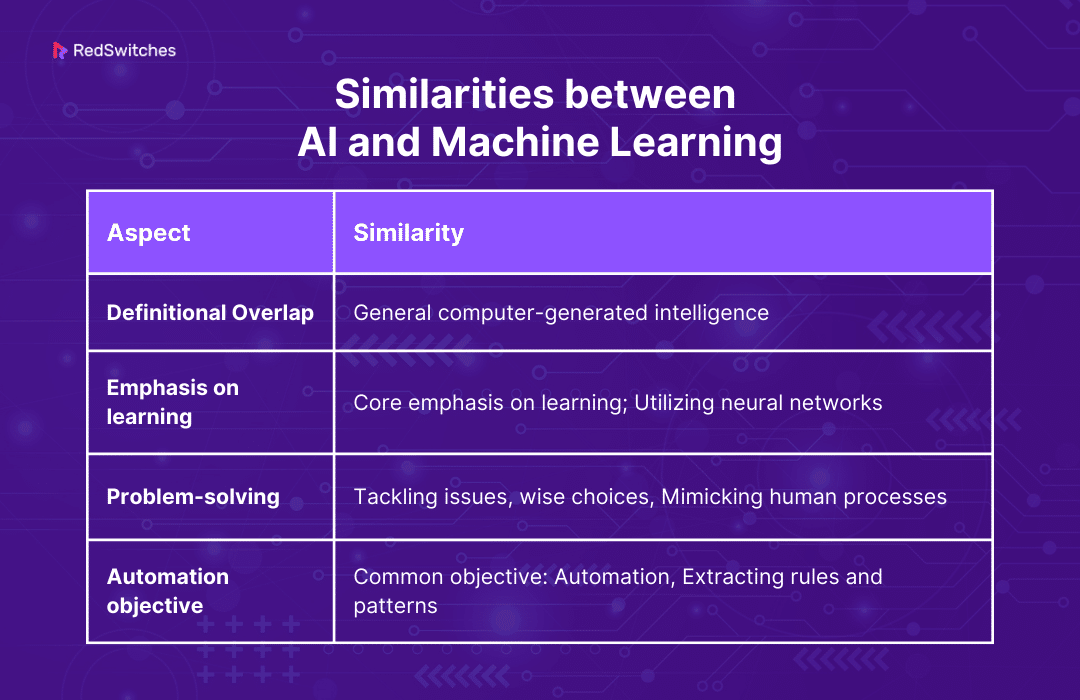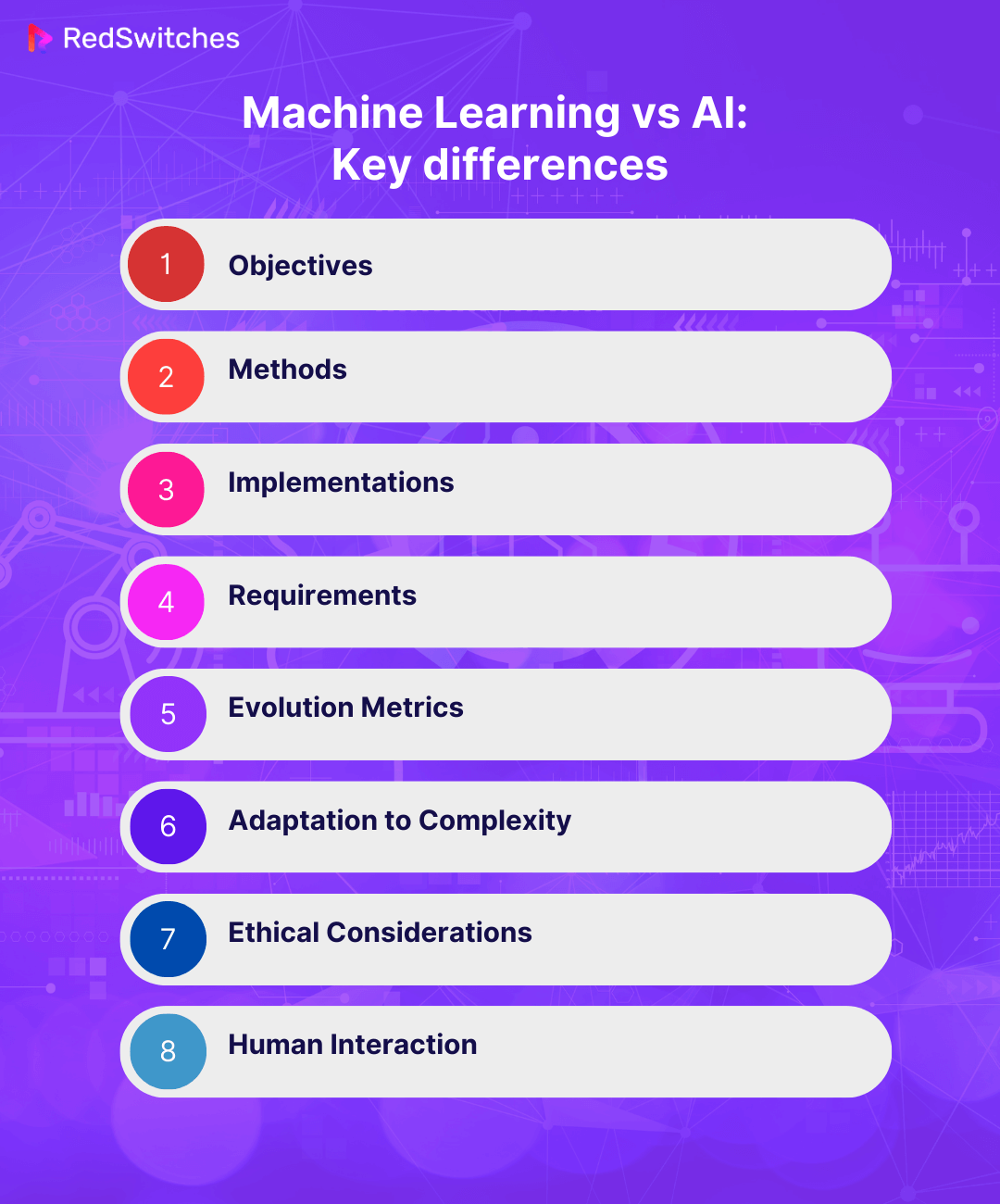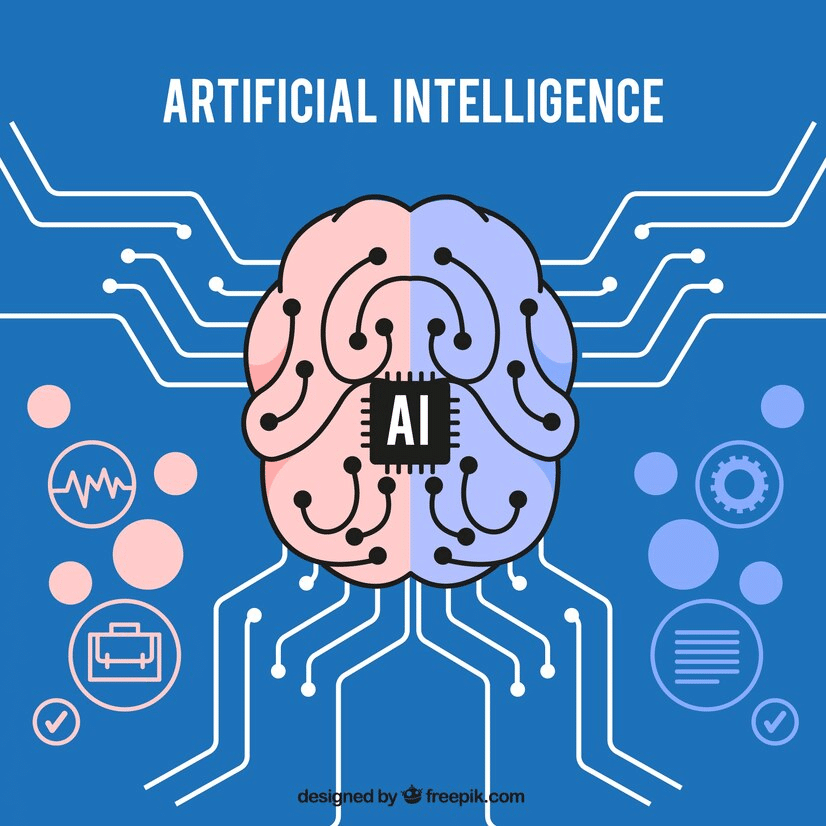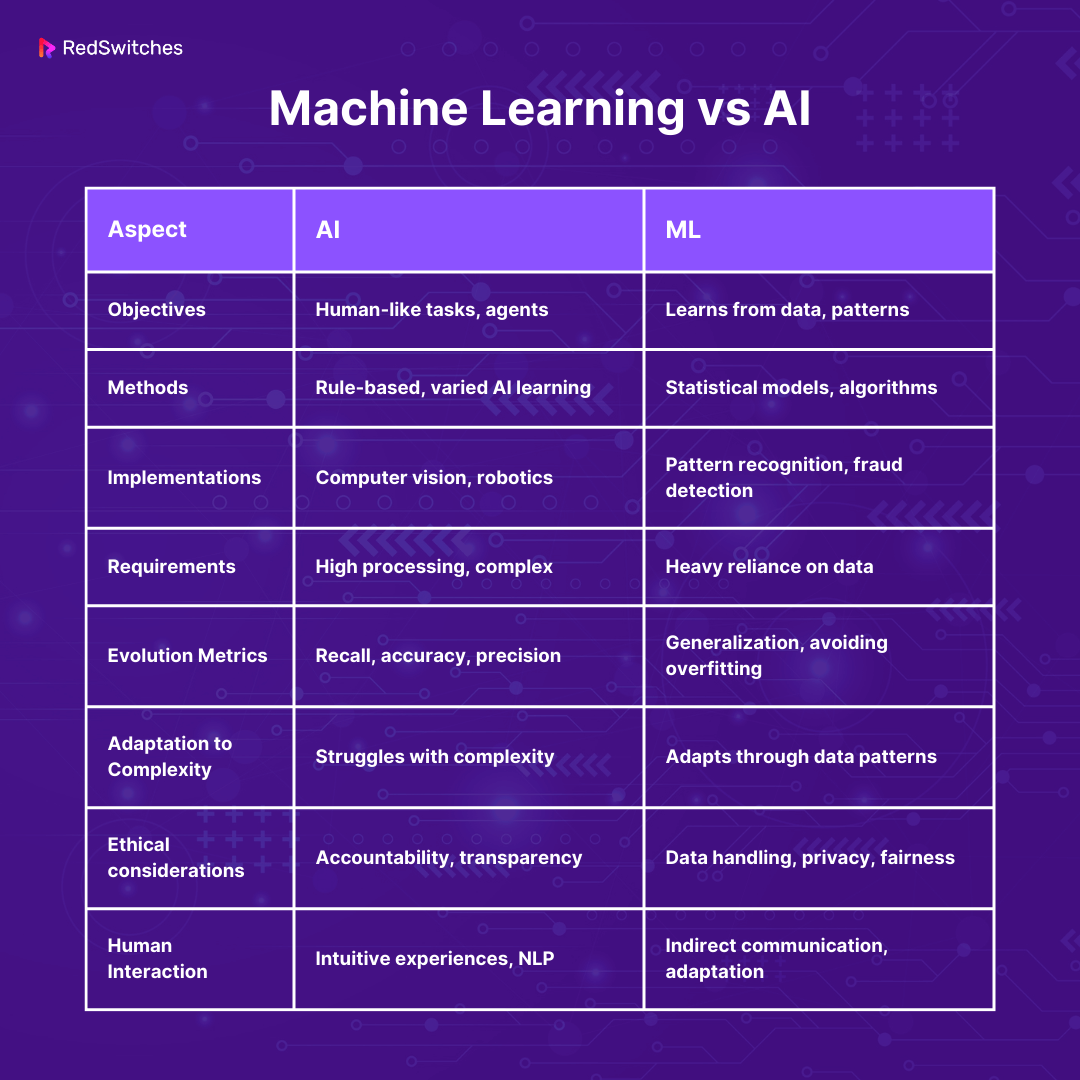Welcome to the fascinating world of machine learning and artificial intelligence (AI), a dynamic battleground where intelligence and algorithms meet. These phrases, frequently used synonymously, have unique meanings that will influence technology in the future. In this blog, we will discover the differences between Machine Learning and Artificial Intelligence, analyzing their goals, approaches, applications, and specifications.
Come along with us as we unravel the mystery of the code driving these revolutionary forces in the rapidly changing field of technology innovation as we travel through its binary complexities. We will understand the difference between AI and machine learning.
Let’s discuss the debate between machine learning vs AI.
Table of Contents
- What is Artificial Intelligence?
- What is Machine Learning?
- What are the similarities between AI and Machine Learning?
- Machine Learning vs AI: Key differences
- Machine Learning vs AI: Objectives
- Machine Learning vs AI: Methods
- Machine Learning vs AI: Implementations
- Machine Learning vs AI: Requirements
- Machine Learning vs AI: Evolution Metrics
- Machine Learning vs AI: Adaptation to Complexity
- Machine Learning vs AI: Ethical Considerations
- Machine Learning vs AI: Human Interaction
- Critical Considerations for Organizations to get started with AI and Machine Learning
- Conclusion
- FAQs
What is Artificial Intelligence?
Credits: Freepik
The duplicate of human intelligence processes by machines, specifically computer systems, is called artificial intelligence. Expert systems, natural language processing, speech recognition, and machine vision are a few specific uses of AI.
Machines with artificial intelligence can mimic or even surpass human mental capacities. As generative AI tools like ChatGPT and Google’s Bard proliferate and self-driving cars become more common, artificial intelligence (AI) is becoming increasingly integrated into daily life, and businesses in every sector are investing in this field.
Also read Big Data Analysis in Cloud Computing: A Detailed Overview
Types of Artificial Intelligence
Credits: Unsplash
Let’s understand the different types of artificial intelligence.
Narrow or Weak AI
This kind of AI is made to accomplish a single task or a small number of tasks, and it frequently outperforms humans in those specialized areas. Virtual personal assistants like Alexa or Siri, image recognition software, and recommendation systems are a few examples. Narrow AI is good at what they are good at, but it doesn’t have the general cognitive skills and self-awareness that come with being human.
General or Strong AI
The theoretical idea of an artificial intelligence (AI) system that can comprehend, absorb, and apply information across a broad range of tasks—basically duplicating human cognitive capabilities—is known as General AI or Strong AI. True general artificial intelligence is still primarily theoretical and has not yet been achieved. Systems that are creative, sentient, adaptive, and capable of every intellectual task a human can be required to reach this degree of artificial intelligence.
Artificial Superintelligence
This is the term for an AI system that is infinitely more intelligent than a human being. The potential for Artificial Superintelligence (ASI) to surpass the most brilliant minds across all domains would enable breakthroughs and inventions beyond human comprehension.
Applications of Artificial Intelligence
Let us understand the applications of Artificial Intelligence.
Healthcare
AI is changing the healthcare industry by improving medication development, customized treatment plans, and diagnostics. Machine learning algorithms examine medical data, including imaging and patient records, to find patterns and help in early disease identification. AI-powered chatbots and virtual health assistants give patients instant information and support, increasing patient accessibility to healthcare.
Finance
Algorithmic trading, risk management, and fraud detection are some of the uses of AI in the financial industry. To detect abnormal trends and possible fraudulent activity, machine learning algorithms examine enormous datasets, guaranteeing the security of financial transactions. AI-driven robo-advisors provide personalized investing solutions based on client preferences and market trends.
Education
By tailoring learning experiences, AI is revolutionizing the field of education. Using machine learning, intelligent teaching systems can adjust to each student’s unique requirements and offer personalized guidance and feedback. Using interactive chatbots and language translation technologies, natural language processing, or NLP, makes language learning easier. AI also helps automate administrative duties, allowing teachers to concentrate more on instruction.
Autonomous Vehicles
The automobile sector is using Artificial Intelligence to produce autonomous vehicles. Machine learning algorithms interpret real-time data from cameras and sensors to navigate and make snap judgments, improving road safety. Autonomous vehicles of the future are becoming increasingly widespread thanks to AI-powered features like lane-keeping assistance and adaptive cruise control.
Retail
Personalized shopping experiences and effective supply chain management are two ways artificial intelligence changes the retail scene. Recommendation systems make customized product recommendations based on an analysis of user preferences.
This increases customer satisfaction and sales. Predictive analytics optimize inventory management, guaranteeing that goods are available when and where needed.
Also Read: Alibaba vs AliExpress: Navigating the E-Commerce Landscape
Pros and cons of AI
In this section, let us understand the Advantages and Disadvantages of Artificial Intelligence.
Pros
Efficiency and Productivity
Artificial intelligence (AI) systems can complete repetitive jobs faster and more accurately than humans. This boosts productivity across various businesses and frees workers to concentrate on more intricate and imaginative areas of their jobs.
Data analysis and insights
AI is highly skilled at swiftly analyzing large amounts of data. With the help of these capabilities, firms can uncover patterns that would not be visible using more conventional techniques, extract insightful information, and make data-driven decisions.
Automation
AI-driven automation lowers the demand for manual labor across various industries. This reduces expenses, expedites procedures, and lessens the possibility of human error—especially for jobs involving repetitive and routine actions.
Better Healthcare
AI applications support personalized treatment regimens, quicker and more accurate diagnosis, and drug discovery. Artificial intelligence (AI) algorithms are able to examine medical data and find trends that can help with early disease identification and improve patient treatment.
Cons
Job Displacement
Job displacement is a worry since automation and AI technologies can potentially replace some jobs. Even if AI opens up new possibilities, it also pressures workers to adjust to changing skill sets, which causes problems in the labor market.
Ethical Concerns and Bias
AI systems may unintentionally reinforce or magnify prejudices in the training data. This raises ethical issues, especially regarding recruiting, law enforcement, and financial decisions. One major problem is making AI systems accountable and fair.
Absence of Intuition and Creativity
Although AI performs well on data-driven tasks, it lacks the intuition and creativity that go into human decision-making. AI systems are limited in handling unfamiliar or unstructured scenarios since they function according to preset algorithms and patterns.
Security dangers
As AI is used more frequently, there are new security dangers. Malicious actors could use AI system vulnerabilities to gain unauthorized access, compromise data, and tamper with AI-driven decision-making processes.
What does an AI engineer do?
Credits: Freepik
A specialist in the design, development, and implementation of artificial intelligence (AI) systems and solutions is known as an AI engineer. The following are some of the main duties and responsibilities of an AI engineer:
AI algorithm design and development: To address particular issues, AI engineers design, develop, and apply AI algorithms like decision trees, random forests, and neural networks.
Data analysis: To find patterns and relationships that can be utilized to train AI models, AI engineers examine and evaluate data using statistical and mathematical methods.
Training and evaluating AI models: AI engineers use big datasets to train AI models, assess their effectiveness, and tweak algorithmic parameters to increase accuracy.
Integration and Deployment: When deploying trained models into production environments, ensure they work well with the current systems.
Interfaces and APIs: Establish interfaces and APIs to facilitate communication between the AI models and other system elements.
Observation and upkeep: Install monitoring systems to keep an eye on the real-time performance of models that have been installed.
Problem Resolution: In light of evolving data patterns and business requirements, resolve problems, update models, and improve algorithms.
Working Together and Communicating: Collaborate closely with teams from different departments, such as domain experts, software engineers, and data scientists.
Also read Before You Buy: The Importance of Reviewing Domain History
What is Machine Learning?
Credits: Freepik
A subset of computer science and artificial AI called “machine learning” aims to use data and algorithms to pretend human learning processes and progressively increase their accuracy.
An essential element of the expanding discipline of data science is machine learning. Algorithms are trained to produce predictions or classifications and to find important information in data mining projects using statistical techniques. Subsequently, these insights inform business and application decisions, ideally influencing essential growth metrics.
Data scientists will be in greater demand as big data grows and flourishes. They’ll have to assist in determining which business inquiries are most pertinent and what information is needed to address them.
Types of Machine Learning
Credits: Freepik
Machine learning is categorized into three types:-
Supervised Learning
Every input data point is associated with the matching desired output and the system is trained on a labeled dataset. The algorithm aims to discover a mapping function that can correctly forecast the result for brand-new, untested data. Classification and regression problems, like spam detection, picture recognition, and home price prediction, are common uses.
Unsupervised Learning
In unsupervised learning, an algorithm is trained on an unlabeled dataset and must find patterns and relationships in the data without human assistance. Common tasks in unsupervised learning are dimensionality reduction and clustering. While dimensionality reduction lowers the number of features in the collection, clustering clusters related data points. Applications of unsupervised learning include anomaly detection and consumer segmentation.
Reinforcement Learning
In the context of machine learning, Reinforcement Learning (RL) is an approach where an algorithm, referred to as an agent, learns to make decisions by interacting with a dynamic environment. The agent’s goal is to achieve a specific objective, and it learns to do so by trial and error, receiving rewards or penalties based on the actions it takes. This method is particularly useful in scenarios where explicit instructions on performing tasks are unavailable, allowing the agent to develop its strategy for optimal behavior.
Applications like game playing, robotic control, and driverless cars frequently use this learning. Through trial and error, the agent picks up new skills and modifies its behavior in response to input from its surroundings.
Applications of Machine Learning
So now, let’s focus on the applications of machine learning.
Healthcare
ML is transforming the healthcare industry by improving diagnosis and treatment strategies. Medical data, such as imaging and patient records, are analyzed by algorithms to find trends and help identify early disease. Predictive analytics and personalized medicine use machine learning (ML) to customize treatment plans based on unique patient characteristics.
Finance
Algorithmic trading, fraud detection, and risk assessment are some of the uses of machine learning in the financial industry. Machine learning algorithms examine transaction patterns to spot irregularities that might be signs of fraud. Predictive models also assist financial organizations in managing and evaluating risks, which promotes better decision-making.
E-commerce and Recommendation Systems
E-commerce platforms utilize ML algorithms to give users customized recommendations. These systems analyze user behavior, purchase history, and preferences to suggest products or services, enhancing the shopping experience and driving customer engagement.
Natural Language Processing (NLP)
NLP is a type of machine learning that allows computers to comprehend, translate, and produce human language. NLP is used by chatbots, virtual assistants, and language translation software to enable human-computer interaction. NLP is also used in sentiment analysis to determine the beliefs and feelings conveyed in textual data.
Also read Database Defense Blueprint: Ensuring Data Security in a Connected World
Pros and Cons of Machine Learning
Let’s discuss the advantages and disadvantages of Machine Learning.
Pros
Automation and Efficiency
Machine learning increases productivity and efficiency by automating repetitive processes. Large dataset analysis, prediction, and sophisticated calculation at a speed not possible for humans are all capabilities of algorithms.
Data-Driven Decision-Making
Using data analysis, machine learning (ML) helps organizations make well-informed judgments. Businesses may make more strategic and successful decisions by using predictive models and analytics to find insights, recognize patterns, and foresee trends.\
Increased Accuracy
As a result of machine learning algorithms’ ongoing learning and adaptation, accuracy increases over time. This is especially advantageous because ML systems can reach high levels of precision in jobs like image recognition, natural language processing, and predictive maintenance.
Personalization
Machine learning (ML) drives customization features across various applications, such as targeted marketing, content recommendations on streaming platforms, and e-commerce recommendation systems. Providing services and content customized to each user’s tastes improves user experiences.
Cons
Data Dependency
The quantity and quality of training data greatly impact machine learning models. Biased or incomplete datasets can produce inaccurate results and biased predictions, creating moral dilemmas and making decision-making more difficult.
Interpretability and Transparency
Many machine learning models, particularly complex ones like deep neural networks, are challenging to understand. It can be challenging to comprehend how these models make decisions, which makes it tough to explain the outcomes and raises questions about accountability and trust.
When a model performs well on training data but cannot generalize to new, unknown data, it is said to be overfitted. This highlights the necessity of meticulous model tuning and validation since it may result in erroneous predictions in real-world circumstances.
Overfitting
When a model performs great on training data but cannot generalize to new, unknown data, it is said to be overfitted. This highlights the necessity of meticulous model tuning and validation since it may result in erroneous predictions in real-world circumstances.
Lack of Common Sense and Creativity
Machine learning models are devoid of both common sense and creativity. They function by identifying patterns in the data, but they might have trouble with tasks that call for human-like intuition, contextual knowledge, and original problem-solving techniques.
What does a Machine Learning engineer do?
A Machine Learning Engineer focuses on designing and implementing machine learning applications and systems. Their key responsibilities include
Data Analysis and Processing: They collect, clean, and analyze large data sets to derive meaningful insights and identify patterns.
Algorithm Development: Developing and selecting appropriate machine learning algorithms and models suited to the specific problem.
Model Training and Testing: Training machine learning models using large datasets and evaluating their performance to ensure accuracy and effectiveness.
Feature Engineering: Identifying and creating relevant features from raw data to improve model performance.
Integration of ML Models: Integrating machine learning models into existing software applications or systems for practical use.
Optimization and Scaling: Optimizing the performance of machine learning models and scaling them to handle large-scale data.
Collaboration with Cross-Functional Teams: Collaborating with data scientists, engineers, and business analysts to align machine learning solutions with business goals.
Keeping Up to Date with Technology: Staying updated with the latest developments in machine learning, artificial intelligence, and related technologies.
Ensuring Ethical AI Practices: Ensuring that AI and machine learning models are ethically designed and do not propagate bias.
Deployment and Maintenance: Deploying models into production environments and maintaining them for reliability and efficiency.
Also read Why Is Data Privacy Important For All Stakeholders?
What are the similarities between AI and Machine Learning?
Before moving into our core topic of Machine learning vs AI, let us understand the similarities between AI and machine learning.
Definitional overlap
Machine learning is a subset of artificial intelligence (AI), although AI is the more general term that includes any computer-generated intelligence. ML is the process of creating algorithms that let computers learn from data and become more efficient without explicit programming. The goal of both is to develop intelligent systems that are capable of doing tasks on their own.
Emphasis on Learning and Adaptation
Learning from experience is at the core of both machine learning and artificial intelligence. Rule-based systems, expert systems, or more sophisticated methods like neural networks can all be used in AI learning.
Problem-solving and Intelligent Decision-Making
AI and ML are used to tackle complex issues and arrive at wise choices. The goal of AI systems, especially those built on machine learning, is to mimic or reproduce human cognitive processes, including reasoning, problem-solving, and decision-making. ML is particularly good at predicting and making judgments based on information and patterns found in data.
Automation
AI and ML have the common objective of automation. Whereas ML automates the process of extracting rules and patterns from data, AI aims to automate actions that traditionally require human intelligence. Artificial intelligence (AI) systems that use machine learning (ML) are better able to automate activities, such as natural language processing and picture identification, without the need for explicit programming.
Let’s summarize it in a table.
| Aspect | Similarity |
| Definitional Overlap | General computer-generated intelligence |
| Emphasis on learning | Core emphasis on learning; Utilizing neural networks |
| Problem-solving | Tackling issues, wise choices, Mimicking human processes |
| Automation objective | Common objective: Automation, Extracting rules and patterns |
Machine Learning vs AI: Key differences
Let’s understand the key differences that will cover our key differences between machine learning vs artificial intelligence.
Machine Learning vs AI: Objectives
The first crucial point in the machine learning vs AI debate is the objectives of the two.
Artificial Intelligence
The goal of artificial intelligence is to build machines capable of doing tasks that normally call for human intelligence. The main objective is to create machines that can reason, plan, solve problems, and perceive and understand natural language. Artificial intelligence aims to create intelligent agents that can replicate human cognitive processes for various applications.
Machine Learning
On the other hand, machine learning’s primary goal is to make it possible for computers to learn from data without explicit programming. The creation of algorithms that enable computers to recognize patterns, anticipate outcomes, and enhance their performance over time in response to data is the main goal of machine learning (ML).
Machine Learning vs AI: Methods
The next difference between AI and machine learning will be the methodology.
Artificial Intelligence
When it comes to methods in the machine learning vs AI debate, both use varied types of methods. A wide range of techniques are used in artificial intelligence, such as rule-based systems, expert systems, and symbolic reasoning. AI systems frequently rely on pre-established rules and knowledge representations when making judgments and resolving issues. This covers a wider variety of methods to attain intelligent behavior.
Machine learning
In contrast, machine learning is centered on statistical models and algorithms. It strongly emphasizes creating systems that can grow and change with experience. The techniques, all aimed at teaching models to provide precise predictions and judgments, include reinforcement learning, unsupervised learning, and supervised learning.
Machine Learning vs AI: Implementations
Let’s discuss how the implementation is done in the machine learning vs AI debate.
Artificial Intelligence
Applications for artificial intelligence can be found in many domains, including computer vision, robotics, natural language processing, and gaming. Artificial intelligence (AI) systems, used in virtual assistants, driverless cars, and expert systems created for specialized jobs, can entail complicated decision-making procedures.
Machine learning
Pattern recognition, recommendation engines, and predictive analytics are all powered by machine learning. Applications such as picture and speech recognition, fraud detection, and personalized content suggestions heavily utilize it. ML systems perform best in tasks that require learning and adapting to new data.
Also, read What is data Integrity? Why it is important in database designs?
Machine Learning vs AI: Requirements
Let’s discuss the machine learning vs AI debate regarding requirements.
Artificial Intelligence
AI implementation frequently necessitates high processing power and complex programming. Developing intelligent agents requires complex algorithms, a lot of resources, and a thorough understanding of the topic; for AI systems to operate at their best, much training and fine-tuning may be required.
Machine learning
On the other hand, machine learning emphasizes data heavily. Both the amount and quality of data are essential to the effectiveness of ML models. Key components of successful machine learning implementations are computational resources for training, a variety of relevant datasets, and robust algorithms.
Credits: Freepik
Machine Learning vs AI: Evolution Metrics
Now, Let’s discuss the machine learning vs AI debate regarding Evolution metrics.
Artificial Intelligence
Evaluating AI systems’ performance requires the use of intricate evaluation metrics. Recall, F1 score, accuracy, and precision are often used metrics to assess how well decisions are made. Artificial intelligence (AI) systems are frequently assessed based on their accuracy in producing outputs, but they also encounter difficulties when context awareness and sophisticated reasoning are crucial.
Machine learning
Metrics like accuracy, precision, recall, and the area under the ROC curve are essential in machine learning. However, the ability of ML models to perform well on fresh, untested data—generalization—is their main area of interest. Common issues with overfitting and underfitting call for careful thought and validation methods to guarantee that models perform effectively over various datasets.
Machine Learning vs AI: Adaptation to Complexity
Let’s explore the differences between machine learning vs AI in their Adaptation to Complexity.
Artificial Intelligence
Artificial intelligence systems frequently struggle with complex decision-making processes. AI faces difficulties with complex jobs requiring reasoning, context awareness, and ambiguous data handling. Attaining human-like intuition and understanding is still a work in progress, and AI systems need to be able to adjust to the intricacies of various circumstances.
Machine learning
Machine learning systems are excellent at using data patterns to learn how to adapt to complexity. Because ML models can identify complex correlations and patterns in massive datasets, they are a good fit for applications where it may be difficult to specify the underlying structure. If machine learning models are trained on representative and diverse data, they can adjust and perform better as complexity rises.
It is one of the most crucial differences between machine learning and artificial intelligence.
Machine Learning vs AI: Ethical Considerations
Let’s explore the differences between machine learning vs AI in terms of Ethical Considerations
Artificial Intelligence
The introduction of artificial intelligence raises ethical concerns about decision accountability, transparency, and potential bias. It is crucial to recognize and solve ethical issues as AI systems affect more and more essential facets of human existence. Careful thought must be given to issues about the ethical application of AI in sectors including healthcare, law enforcement, and finance.
Machine learning
In machine learning, ethical considerations encompass appropriate data handling, including concerns about security, privacy, and potential biases in training datasets. Ensuring that ML models are developed and applied ethically and somewhat is crucial since they impact decision-making processes.
Machine Learning vs AI: Human Interaction
Now, Let’s explore the differences between machine learning vs AI in Human Interaction.
Artificial Intelligence
Human-centric system design is a common practice in artificial intelligence. The aim is to provide intuitive user experiences and to facilitate smooth communication between humans and robots. An essential component of AI’s goals for human contact is comprehending user behavior and preferences and integrating natural language processing.
Machine learning
Human contact has a different nuance in machine learning. ML systems are excellent at indirect communication because they can adjust over time by changing user behavior. The task involves creating user interfaces that enable comprehension and confidence in learning, promoting cooperation between intelligent systems and humans.
Let’s summarize it in a tabular format.
| Aspect | AI | ML |
| Objectives | Human-like tasks, agents | Learns from data, patterns |
| Methods | Rule-based, varied AI learning | Statistical models, algorithms |
| Implementations | Computer vision, robotics | Pattern recognition, fraud detection |
| Requirements | High processing, complex | Heavy reliance on data |
| Evolution Metrics | Recall, accuracy, precision | Generalization, avoiding overfitting |
| Adaptation to Complexity | Struggles with complexity | Adapts through data patterns |
| Ethical considerations | Accountability, transparency | Data handling, privacy, fairness |
| Human Interaction | Intuitive experiences, NLP | Indirect communication, adaptation |
Critical Considerations for Organizations to get started with AI and Machine Learning
Let’s learn about the considerations for Organizations to start with AI and machine learning.
Define Specific Goals
- Clearly state what the organization hopes to accomplish with AI and ML regarding goals and objectives.
- Determine which company issues or procedures can gain from data-driven decision-making and intelligent automation.
Create a Talented Group
- Put together people with experience in AI development, machine learning, and data science.
- To create an effective AI/ML team, spend money on training current staff members or recruiting qualified experts.
Infrastructure for Data
- To ensure the organization can handle massive volumes of varied, high-quality data, evaluate and improve its infrastructure.
- To ensure data security, accuracy, and compliance, put strong data governance procedures into place.
Gathering and preparing data
- Locate pertinent data sources and gather the information that supports the stated goals.
- Preprocess and clean the data to remove missing values, inconsistent information, and extraneous information to ensure it is appropriate for model training.
Select the Right Frameworks and Tools
- Choose appropriate AI and ML frameworks and technologies according to the team’s experience and the organization’s needs.
- For machine learning, popular frameworks include scikit-learn, PyTorch, and TensorFlow. Popular platforms are TensorFlow Extended (TFX) for end-to-end machine learning pipelines.
Conclusion
In conclusion, delving into the nuanced differences between artificial intelligence and machine learning has provided valuable insights into these transformative technologies. We’ve unpacked their definitions, explored real-world applications, weighed their pros and cons, and pinpointed eight key factors differentiating them.
Understanding these technologies is crucial as they reshape our world. Companies like ours are leading this tech revolution, leveraging AI and machine learning to enhance efficiency, foster innovation, and guide the digital economy’s trajectory.
Integrating these technologies can unlock unprecedented opportunities and radically alter our interaction with the digital world. Explore these possibilities with us at RedSwitches and with their Dedicated Servers, where we’re harnessing the power of AI and machine learning to redefine the future. Join us on this journey and see how we can transform your digital landscape.
FAQs
Q. Should we learn AI or ML?
The choice between learning AI or ML depends on your interests: AI covers a broad spectrum of intelligent behavior in machines. ML focuses explicitly on developing algorithms that enable these machines to learn and make decisions from data.
Q. Which is best for future AI or ML?
Both AI and ML are crucial for the future. AI encompasses a wider vision for creating intelligent machines, while ML is a practical tool within AI, essential for implementing data-driven solutions.
Q. Does AI need maths?
Yes, AI requires a solid understanding of mathematics, particularly statistics and linear algebra, to develop and understand algorithms that drive AI systems.
Q. Is ChatGPT a type of AI?
ChatGPT is indeed a type of AI, specifically a language model developed by OpenAI that uses machine learning to generate human-like text based on the input it receives.
Q. Which is better, AI or data science?
AI and data science have distinct roles: AI focuses on creating machines capable of intelligent behavior, while data science is more about extracting insights and knowledge from data.
Q. What is the difference between AI and machine learning?
Artificial intelligence (AI) is a broader concept of machines being able to carry out tasks in a way that we would consider “smart,” while machine learning is a subset of AI, focused on the ability of machines to learn from data.
Q. How are deep learning and neural networks related to machine learning and AI?
Deep learning is a subset of machine learning, which in turn is a subset of AI. Deep learning uses artificial neural networks to teach machines to perform tasks without being explicitly programmed.
Q. What are some applications of AI and machine learning in real-world scenarios?
AI and machine learning have various applications, including natural language processing, image and voice recognition, recommendation systems, predictive analytics, and autonomous vehicles.
Q. How do companies use AI and machine learning in their operations?
Companies use AI and machine learning to optimize business processes, improve customer experience, automate repetitive tasks, enhance decision-making, and develop innovative products and services.
Q. What is deep learning and how does it differ from machine learning?
Deep learning is a subset of machine learning that uses deep neural networks to handle unstructured data, enabling machines to mimic human-like decision-making processes more effectively.
Q. What are the key differences between machine learning and artificial intelligence?
While AI encompasses the broader concept of machines exhibiting human-like intelligence, machine learning focuses specifically on the ability of machines to learn from data and improve over time.
Q. How do AI tools facilitate the learning process for machines?
AI tools enable machines to process and analyze vast amounts of data, learn patterns and correlations, make predictions, and continuously refine their models without explicit programming.
Q. What is the difference between machine learning and deep learning algorithms?
Machine learning algorithms are designed to learn from data and make predictions, while deep learning algorithms, based on neural networks, are specifically adept at processing unstructured data and performing complex pattern recognition tasks.
Q. How do AI and machine learning contribute to problem-solving and decision-making?
AI and machine learning algorithms aid in identifying patterns, trends, and anomalies in data, thus enabling better problem-solving and decision-making processes based on data-driven insights.
Q. Why is AI and machine learning usage expected to grow in 2024 and beyond?
The increasing availability of big data, advancements in computing power, and the potential for AI and machine learning to drive innovation and efficiency across various industries are key factors driving the growing adoption of these technologies in 2024 and beyond.
